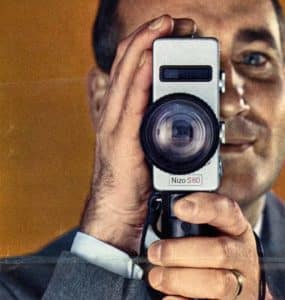Free UK shipping & Free worldwide shipping on orders over £200
February 6, 2025
Super 8 film offers a unique, nostalgic aesthetic that modern digital cameras simply can’t replicate. Whether you’re a seasoned filmmaker or just starting, shooting on Super 8 requires a few key considerations to get the best results. Here are the essential things to remember when filming on Super 8.
Most Super 8 cameras are over 50 years old. It’s important to regularly test your super 8 camera especially in advance of an upcoming shoot. Listen for any unusual noises, check that the film advances correctly, and ensure the exposure system is functioning properly. Having a backup camera is also a great idea, especially for important shoots.
A dirty film gate can ruin your footage by causing scratches, dust spots, or uneven exposure. Use a soft brush, like a child’s toothbrush, to gently clean the film gate between each roll. This small step can make a big difference in maintaining crisp and clear footage.
Super 8 cameras rely on batteries for operation, and nothing is worse than running out of power mid-shoot. Always carry spare batteries and a selection of film stocks to adapt to different lighting conditions. Camera Crate offers a variety of Super 8 film stocks to help you achieve the perfect look for any scene.
Most Super 8 cameras include a footage counter that tracks how much film remains. Before swapping cartridges, check the remaining footage—opening the film door resets the counter. One advantage of Super 8 is the ability to switch film mid-roll, which is useful if lighting conditions change. To avoid exposing your last shot, film for a second or two before removing the cartridge and do the same when inserting the new one.
If you’re taking your Super 8 film through airport security, be aware that X-ray machines can damage it. Always carry your film in your hand luggage and request a manual inspection to avoid potential exposure.
Super 8 cameras are typically designed to shoot at 18 frames per second (fps), providing around 3 minutes and 20 seconds of runtime per cartridge. This frame rate delivers the iconic, nostalgic look of Super 8 home movies. If you want a more cinematic feel, shoot at 24fps, though this will reduce runtime to about 2 minutes and 40 seconds per cartridge.
Super 8 cameras use automatic exposure systems that prioritize the brightest part of the frame. If a strong light source—such as the sun, a lamp, or a window—is visible, it will be correctly exposed while the rest of your image may appear too dark. To prevent this, position yourself so that the sun is behind you when filming outdoors. Some cameras also feature a backlight button that increases exposure by one stop, which can help balance lighting in tricky situations. If you want really accurate footage it’s best to consider using an external light meter to ensure you’re correctly exposing exactly what you want exposed.
We hope you enjoyed our tips for filming on super 8. If you’re looking to get into Super 8 filmmaking, Camera Crate offers a curated selection of tested and reliable Super 8 cameras. We ensure every camera is in working condition and ready to capture stunning vintage footage. Plus, with free UK tracked shipping, free worldwide shipping on orders over £200, a 30-day returns policy, and a 60-day warranty, you can buy with confidence.
Explore our range of Super 8 cameras and film stocks today at CameraCrate.com and start your journey into the timeless world of Super 8 filmmaking!

© 2025, CameraCrate.com
Company Number: 12789078
VAT Number 355133808
© 2025, CameraCrate.com
Company Number: 12789078
VAT Number 355133808